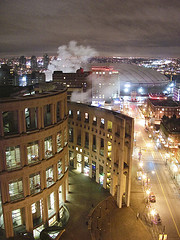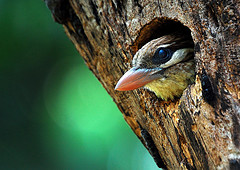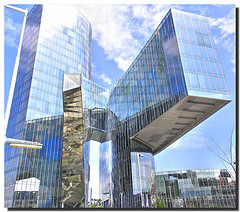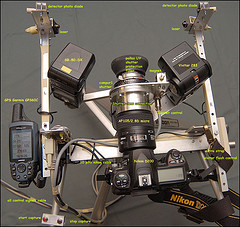From the Province – http://www.theprovince.com/sports/soccer+robot+competes+World/3150084/story.html
Mining Engineering professor Marcello Veiga sings parodies in his Mining and Environment (MINE 391) students to explain the environmental and social effects of mining and he claims that new miners must change their attitudes..
This is a parody telling the story of a irresponsible miner who believes that he can extract gold using mercury and dump everything in the rivers because nobody is watching him in a remote site in the North of Canada.
Very cool…Hats off to UBC APSC Communication Office for sharing this one
The Huffington Post had a post yesterday about some beautiful world libraries. Personally, I liked the Yale’s Rare books library…
For books on libraries architecture, please see this link – http://resolve.library.ubc.ca/cgi-bin/catsearch?subject=Library+architecture
** photo by http://www.flickr.com/photos/selva/
The BBC has reported last week about scientists in Italy making artificial replacement bones out of wood – http://news.bbc.co.uk/2/hi/health/8438209.stm
A quick search in the Compendex database shows dozens and dozens of research reports of using wood as a possible implant material.
** photo by http://www.flickr.com/photos/challiyan/
Ron Simmer Patent and IP Expert has once agained issued his Patex Bizarre Patents Calendar.
This calendar documents the creative spirt of the human race reflected in patents.
Check out Ron’s excellent site of patent and intellectual property links at the Patex website.
Submitted by Kevin Lindstrom Science and Engineering Liaison Librarian
Most of us spend our university education taking the standard, required courses, there are more than just the basics out there when it comes to some science classes.
This blog post list some of the most hilarious of them – http://www.onlineuniversities.com/blog/2009/10/100-hilarious-college-courses-that-really-exist/
Personally, I would love to take some of the science classes such as :
The Science of Superheroes: While it might sound like fun and games, this course takes superheroes as a means to teach students real lessons about physics. [U of California Irvine] or Lego Robotics: Legos can help you build more than just that TIE Fighter, they can also be used to make real robots, as this course will show students. [MIT]
** Photo by http://www.flickr.com/photos/jocorvera/
Yesterday’s article in NYT fascinated me with its title – “As Unbreakable as … Glass?”
There is lots of research in this area that you can find in Web of Science database, Compendex database, and of course in the standard-bearer for anything chemical – SciFinder Scholar database.
We also own hundreds of books on this topic. Here is the short list for Glass.
** photo by smb
Statistics isn’t just about bayesian disease mapping and analyzing incomplete multivariate data. Statistics has some very important applications for analyzing hockey – yes, ice hockey. While my team hasn’t made the playoffs for a while except for that glorious 2006 run, it might be interesting to for any of you hockey statisticians to apply the research to the teams currently playing in the NHL playoffs.
Here’s a sample of some the articles available in MathSciNet and Current Index to Statistics dealing with ice hockey.
Thomas, Andrew C. (2007) “Inter-arrival Times of Goals in Ice Hockey,” Journal of Quantitative Analysis in Sports: Volume 3: Issue 3, Article 5. Available at: http://www.bepress.com/jqas/vol3/iss3/5
Thomas, Andrew C. (2006) “The Impact of Puck Possession and Location on Ice Hockey Strategy,” Journal of Quantitative Analysis in Sports: Volume 2: Issue 1, Article 6. Available at: http://www.bepress.com/jqas/vol2/iss1/6
Anthology of Statistics in Sports. Edited by Jim Albert, Jay Bennett and James J. Cochran. ASA-SIAM Series on Statistics and Applied Probability, 16. 2005.
Gill, Paramjit S. (2000) “Late-Game Reversals in Professional Basketball, Football, and Hockey” The American Statistician, Volume 54, Number 2 (May, 2000), pp. 94-99 http://www.jstor.org/stable/2686024
The Journal of Quantitative Analysis in Sports is a great place to browse.
Submitted by Kevin Lindstrom UBC Science and Engineering Librarian
Canada Excellence Research Chairs – Phase 1 Competition Results
Overview
In 2008, the Government of Canada created a new permanent program to establish 20 prestigious research chairs–Canada Excellence Research Chairs (CERC)–in universities across the country. The CERC program invests $28 million a year to attract and retain the world’s most accomplished and promising minds and help Canada build a critical mass of expertise in the priority research areas of environmental sciences and technologies, natural resources and energy, health and related life sciences and technologies, and information and communication technologies.
The following 17 universities have been invited to compete in Phase 2.
Universities invited to Phase 2 competition
(Number of successful proposals arranged from West to East)
* University of British Columbia (4)
* University of Alberta (5)
* University of Calgary (1)
* University of Saskatchewan (1)
* University of Manitoba (1)
* University of Toronto (5)
* University of Waterloo (4)
* McMaster University (2)
* Queen’s University (1)
* University of Western Ontario (2)
* University of Ottawa (2)
* McGill University (4)
* Université Laval (3)
* Université de Sherbrooke (1)
* Université du Québec à Trois-Rivières (1)
* University of Prince Edward Island (1)
* Dalhousie University (2)
Click here for a list of the successful proposals
Submitted by Kevin Lindstrom Liaison Librarian
Educause has released its new report – “7 Things You Should Know About Location-Aware Applications“.
Location-aware applications deliver online content to users based on their physical location. Various technologies employ GPS, cell phone infrastructure, or wireless access points to identify where electronic devices such as mobile phones or laptops are, and users can choose to share that information with location-aware applications. As mobile devices offer greater amounts of data about the environment through which we move, location-aware systems will become increasingly effective at predicting what users would like to know about in the geographical space around them, offering a layer of knowledge superimposed on the physical world that can be accessed for information and convenience.
You can research this topic in many of our online databases, however, IEEE digital Library would be your first source. Try this search in IEEE database – http://tinyurl.com/d6y5aj
** Photo by fotoopa
UBC SciEng Librarians:
- About this blog
- Amusing stuff
- Astronomy
- Atmospheric Science
- Chemical and Biological Engineering
- Chemistry
- Civil Engineering
- Computer Science
- Earth and Ocean Sciences
- Electrical and Computer Engineering
- General Science
- Geography
- Green Technology
- Main
- Materials Engineering
- Mathematics
- Mechanical Engineering
- Mining engineering
- News
- Olympics
- Patents
- People
- Physics
- Podcasts
- Science – undegraduate classes
- Statistics
- Teaching
- Uncategorized
- Wood Sciences
Categories
Search This Blog
- July 2010
- June 2010
- May 2010
- April 2010
- March 2010
- February 2010
- January 2010
- December 2009
- November 2009
- October 2009
- September 2009
- August 2009
- July 2009
- June 2009
- May 2009
- April 2009
- March 2009
- February 2009
- January 2009
- December 2008
- November 2008
- October 2008
- September 2008
- August 2008
- July 2008
- June 2008
- May 2008
- April 2008
- March 2008
Archives
- An error has occurred, which probably means the feed is down. Try again later.





